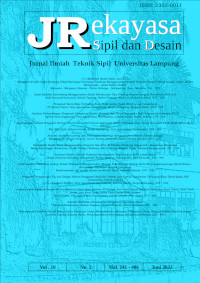Performance Method of Maximum Daily Rainfall Frequency Analysis Using Correlation
DOI:
https://doi.org/10.23960/jrsdd.v8i1.1277Abstract Views: 158 File Views: 749
Abstract
Rainfall in Bandar Lampung has a different distribution value for each station which is calculated to carry out the annual maximum daily rain forecast required in road planning, water building and drainage. Getting rain distribution values requires a method that meets the requirements of Cs, Ck and Cv. But this study reviews methods that have a correlation value close to the value of one.
In this study, a validation test was carried out in advance to normalize values> 500 mm which were then calculated through the Normal, Log Normal, Gumbel and Log Pearson III methods. Look at the correlation value of each method with a scatter diagram.
Analysis of the calculation of the rain distribution method at the Sukarame rain station (PH-003) Log Normal method has a value of 0.96 which has a correlation coefficient value that is closest to the value of 1 (one) among the other methods in all rain stations. Log Normal method has the best average correlation value that is 0.85 then the Normal method has a mean correlation value of 0.74 followed by Log Pearson III method with an average correlation value of 0.35 and the mean correlation value of the Gumbel method -0.01. The correlation value obtained using the Log Normal method is seen both at Sumberejo, Sukarame and Pahoman stations. However, at the Sumur Putri station the value of the Log Pearson III correlation, with the normal log method, the data correlation value is the best because the data fluctuations are close to the value of 1 compared to other methods.
Keywords: Correlation, Rainfall, Normal Method, Log Normal Method, Gumbel Method, Log Pearson III Method.
Downloads
Downloads
Published
How to Cite
Issue
Section
License

JRSDD is licensed under a Creative Commons Attribution-NonCommercial 4.0 International License.

